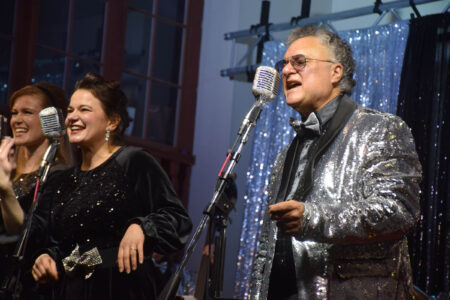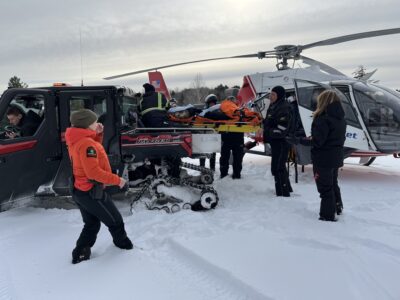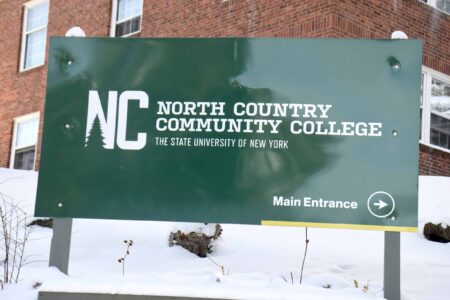Saranac Lake’s infrastructure projects, ranked
Village seeks public input on draft capital improvement plan
SARANAC LAKE — The village has a plan for how to prioritize its spending on large-scale infrastructure projects around Saranac Lake, and it’s looking for public feedback on the plan before voting to adopt it.
Over the past year, a Capital Improvement Plan task force has dug through dozens of projects in the village’s 30-or-so existing capital project plans to create a comprehensive list of the improvements the village plans to make to its parks, sidewalks and water, sewer and public safety infrastructure.
Villagers will be able to give their feedback on the draft Capital Improvement Plan this month, before the village board votes on whether to adopt it.
Public input will be accepted until Sept. 26 at 4 p.m. and can be sent to: clerk@saranaclakeny.gov. The 72-page draft CIP document can be found at tinyurl.com/mvf6bhe6.
Trustee Kelly Brunette said they want many eyes on the draft. The more people who give their input, the better informed the village is, she said.
The village has $40 million in assets — buildings; parks; sidewalks; water, sewer and stormwater infrastructure; equipment and 28 miles of streets.
The CIP addresses capital projects — ones that cost $50,000 or more — not just routine maintenance.
Brunette said having a CIP is best practice for a local government. She had it on her mind to create one for quite a while and has been working on it since she got elected in 2021.
The village has many projects and plans, so many that they can get overlooked, duplicated or slip through the cracks. Brunette said the CIP has the village focus on one, and then another, so that none get lost.
She also said having a CIP helps the village fund these projects.
“By demonstrating that we’re ready and organized, the CIP makes us more competitive for state and federal funding,” Brunette said.
The CIP task force was established in March 2024 and worked with Municipal Solutions, Inc. to develop the draft plan.
This includes 18 high-priority projects, totaling approximately $115 million. To create the draft plan, the task force pulled projects from 30-or-so existing plans — a total of 150 projects, cutting out several redundancies.
Two open houses were held to get input from the public as they created the draft plan. Brunette said everything people mentioned at these sessions was already in a plan — except for the concept for an indoor sports facility.
This draft plan is a culmination of years of smaller village infrastructure plans, formalizing them into one big document, introducing potential new projects and bringing them all into alignment.
“The CIP serves as both an internal planning tool for budgeting and project coordination, and as a public document to communicate priorities to residents, funding partners and regulatory agencies,” according to its executive summary.
The plan is to be reviewed and updated annually, probably around budget season, Mayor Jimmy Williams said. Village Manager Bachana Tsiklauri said he would likely review it quarterly, personally.
Brunette said there’s no one at the village who knows as much about all of its ongoing projects as Tsiklauri does.
The plan is “adaptable” and can be reprioritized, if needed. It is a document meant to be used by future boards and future generations.
“One of the guiding principles behind the CIP is to avoid sudden spikes in property tax or utility fees,” the draft plan states.
It is meant to help the village handle debt, find funding and align budgets.
Brunette said if the plan is adopted this fall, it would be good timing for the village, because the document would be ready when the board and staff start discussing the budget in mid-winter.
The task force developed a “Project Prioritization Matrix” to rank each project on several factors — if the project meets the village goals, how much it impacts the budget, what sort of funding is available, how much it mitigates risk, if it complies with laws or regulations or if it would have an economic or community impact — on a scale of 0 to 100. Brunette said the matrix took six months to develop and fine-tune.
Under the matrix, the closer a project is to being acted on — if it has funding or designs — the higher it is on the list.
The plan says water and wastewater projects are the most significant and the most costly. But they have a direct impact on public health, environmental quality and the village’s future development potential.
“Even if you don’t think about sewers, storm drains or parking lots every day, you depend on them,” Brunette said. “This plan is how we protect and strengthen the systems that serve us all.”
There are also several “pipeline projects” — ones that didn’t make cut, but may be considered in the future. These include expanding recreation at Mount Pisgah, turning the current highway crew sand pit into housing or recreation, a flood response and stormwater mitigation plan, downtown parking expansion, expanding water service, trail connections or expanded fiber optic connection.
Brunette thanked fellow task force members Charlotte Lomino, Jeremy Evans, Jerry Michael, Rick Weber, Tammara Van Ryn, Bachana Tskilauri and fellow Trustee Matt Scollin for their “commitment and expertise” in the process.
Below is a list of the 18 high-priority projects, listed in order of highest-scoring to lowest-scoring.
–
Dorsey Street lot
–
The redesign and resurfacing of the Dorsey Street parking lot scored a 55, is estimated to cost $576,629 and can be fully covered by grants.
Plans include a bus stop, new walkways and a safer and nicer-looking lot.
–
Sidewalks
–
A project for villagewide sidewalk improvements scored a 55 and is estimated to cost $2 million. The village puts around $186,000 in its budget for sidewalk work annually. It also has $105,515 in its current sidewalk capital reserve and could get an unspecified amount of NYS CHIPS grant money.
The project would replace or install sidewalks in high-priority areas like Shepard Avenue or Pine Street with sidewalks compliant with the Americans with Disabilities Act.
Brunette said the village Department of Public Works has its own schedule for sidewalk repairs. This project exists outside of that schedule and reevaluates if that schedule makes sense with other plans. She also said the task force updated the village’s sidewalk inventory for the first time in 10 years.
–
Baldwin Park
–
The project to redevelop Baldwin Park on Lake Flower Avenue scored a 55, and is estimated to cost $1,193,249. The village has $894,937 in grants for this work and estimates $298,312 can be made through the combination of in-kind services and fund balance expenses.
–
Water sourcing
–
The water sourcing and distribution project scored a 55, is estimated to cost $22 million and would have an annual operating cost of $2.7 million. The village has $3 million in its reserves and $5 million in grants to spend on this project. It would require the village to take out around $14 million in debt through 30-year loans with 0% interest. This works out to around $466,666 per year. This is estimated to result in a 24.7% increase in village operating costs.
The project would potentially get the village a new surface water source — possibly at McKenzie Pond again — to supplement the high-iron and low-production well water the village currently uses as its source.
To read more about this project, go to tinyurl.com/5252dt6s.
–
Garwood Park
–
The project to upgrade Garwood Park with an accessible playground scored a 50 and is estimated at costing $355,000, but the CIP points out that number is seven years old and it is probably higher now. The funding for this project would come out of the village’s annual budget.
William Wallace Park and Lake Colby Beach
The project to redevelop William Wallace Park and Lake Colby Beach with a pavilion, play area, canoe kayak storage and other recreational additions scored a 50 and is estimated to cost $1.5 million. The CIP does not list funding sources for this project, but says grants may be available.
–
Sewer lines
–
The project to upgrade aging sewer infrastructure scored a 50 and is estimated to cost $5.8 million. The CIP says the village has $5.2 million in grants, $500,000 in fund balance and $61,477 in reserves to spend on the project.
Riverwalk
The project to finish improving the Riverwalk scored a 45 and is estimated to cost $120,000. The CIP says $100,000 in the fund balance could be used for this project, and there are possible grants.
This project would improve the safety and aesthetics of the walking path and address the missing links in the trail.
–
Church Street sidewalk
–
The project to improve the sidewalk on Church Street scored a 45 and did not have an estimated cost. It did not list any known funding, but said grants could apply to the project.
Riverside Park
The project to upgrade Riverside Park with a new bandshell, restrooms and aesthetics scored a 40 and is estimated to cost $460,000. It did not list any known funding, but said grants could apply to the project.
–
Boothe River Park
–
The project to build the Boothe River Park for paddlers on the mouth of the Saranac River below Lake Flower scored a 35 and is estimated to cost $1.5 million. There is $441,000 in funding from a Downtown Revitalization Initiative grant identified in the plan, with more grants possible.
To read more about this project, go to tinyurl.com/3frwxkcf.
–
New fire department truck
–
The plan to purchase a new heavy rescue truck for the fire department by 2027 scored a 35 and is estimated to cost $900,000.
The village has $808,000 in its reserves and $92,000 in its fund balance to spend on the vehicle.
The current heavy rescue truck is “nearing the end of its serviceable life” and the village has been reserving money each year for a replacement.
“Those reserves combined with a short-term lease or bank loan will cover the heavy rescue truck purchase without a large single-year spike,” the plan states.
–
Fields at landfill
–
The project to build recreation fields at the former village landfill on Willow Way scored a 35 and is estimated to cost $400,000. This has been a long-spoken about plan to turn the large flat area into something useful.
The village has $220,000 in grants for this project.
–
Woodruff Street
–
The project to improve the Woodruff Street corridor for pedestrians and cyclists scored a 35 and is estimated to cost $225,000.
It has full funding from the DRI, but the DRI funding was supposed to be $2.5 million. It’s been reduced as there is not much DRI funding remaining.
–
1-3 Main St.
–
The project to restore the hydroelectric generation capacity at the historic Power and Light at 1-3 Main St. scored a 30 and is estimated to cost $701,750. The village has $526,313 in a state Historic Preservation grant and $175,437 from its fund balance to fund the project.
The project would refurbish the turbine, penstock and controls at the power-generating facility so it can continue to produce renewable power for the village.
–
Prescott-IPW Park
–
The project to improve Prescott-IPW Park on River Street scored a 30 and is estimated to cost $466,000. No funding was identified yet, but it could get state grants.
The project would create a canoe and kayak launch, an improved Ice Palace construction area, have picnic tables, grills, improved fishing access and opportunities for youth programming.
–
Sewer collection upgrades
–
The project to upgrade the village’s 100-year-old sewer collection system scored a 30 and is estimated to cost $49 million with an annual operating cost of $566,666. The village has $17 million in grants from the federal Bipartisan Infrastructure Law, and could possibly get more.
The village anticipates that around one-third of the project costs will be passed on to ratepayers. The village would take out a 30-year, 0%-interest loan of at least $17 million. This would be paid back at around $566,666 per year, around a 20% increase in operating costs.
–
Public safety building
–
The plan to build a public safety building for police, fire and rescue services at 33 Petrova Ave. scored a 15 and is estimated to cost $27.5 million.
The village has around $5.2 million in grants for this project currently, and around $2 million remaining in a reserve fund. The CIP projects the village would need to take out a 30-year, 0%-interest loan of $19,324,500. This would be paid back at around $644,150 per year.
This project is highly contentious among neighbors and other village residents. The CIP task force noted that in the current state of the project’s funding, it would pose “significant financial challenges.”
“Its score reflects factors such as the impact it would have on Village finances if locally funded, and the fact that the concept is still being refined,” according to the CIP. “Community feedback revealed support for improved facilities but also significant concern about cost and location. For these reasons, while the Emergency Services Complex remains in the CIP as a recognized need, it is categorized differently from other projects — essentially as a placeholder for long-term planning, contingent on further analysis, potential cost reductions and securing outside funding.”






